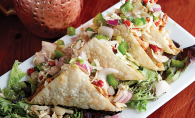The Lake Elmo Inn sits at an inconspicuous intersection of town, next to the railroad tracks that brought visitors by the boxcar-load to its doors decades ago. The trains still pass by occasionally, but the customers now arrive in the comfort of their own vehicles. Since its inception, the inn served as a diner, candy shop, bar, hotel and meeting place for generations of Minnesotans and Wisconsinites. It is fitting, then, that the next generation of talent in the service industry should start their training at a restaurant that wears its past with pride.
Sitting in a booth in the middle of the restaurant bar that has stood since 1881, owner John Schiltz and executive chefs Mike Juelich and Ed Douglass school me on growing up in the restaurant business. “I started as a dishwasher and didn’t go to culinary school. I worked my way through many restaurants and many roles as a chef to become an executive,” Douglass says of his career. All three agree that this path is typical for workers in food service: hired as a dishwasher or busser, then moving to food prep to hors d’oeuvres to appetizers, to lead cook/sous chef and ultimately, the top. But Juelich’s path was slightly different: “I started here in ’91 with very little experience, then finished chef school in ’92. I took a job with minimum wage at the time, but the experience is far more than what I would’ve gotten in school.”
John Schiltz proudly shares that he currently holds the title of longest-standing owner of the Lake Elmo Inn, a 33-year run that shows no signs of slowing down. Educated at the St. Paul College of Culinary Arts, Schiltz started at Lake Elmo Inn much as Juelich did: “I worked while I went to school,” he says. “I still use the things that I learned at culinary school.” Those skills are everything from decorating cakes to breaking down a side of beef or elk to cutting ice from the block. “I think if you don’t use these skills, you lose them,” he says. Schiltz likes to keep his chef muscles limber by continuing to practice these prep skills so that he can set a good example for the apprentices he takes into his restaurant. Plus, a chef who can understand every task can often understand the needs of his staff.
Apprentices at the Lake Elmo Inn arrive with diverse skill sets and backgrounds. “We bring in a lot of young people who are going to school, and we will train them; we are also willing to train anybody who loves this job,” Schiltz says. “They get everything from meat cutting and desserts to banquets and institutional cooking to everything in a gourmet restaurant. The volume that Mike deals with—you just have to do it” to get the experience. The Lake Elmo Events Center is a bastion of catering knowledge that apprentice chefs can experience in tandem with their restaurant training.
Knowing how to do the job is only half of it. Schiltz, Juelich and Douglass each believe that creating a special guest experience is just as important as possessing a commanding set of chef skills. “We have customers that come here for prom, then we might see them for the engagement,” Schiltz says. “Then we see them on the anniversaries or on Mother’s Day, bringing their kids through. It’s a wonderful cycle.”
“We believe we are one of the restaurants known for best food,” he adds, weighing the options for signature dish. “Duck has been on the menu since Day 1”; there’s a juicy roast duckling dinner entrée ($26) and the signature wild rice and duck soup ($6 cup/$8 bowl). Duck is a classic, but the crew is especially proud of its steak. Lake Elmo Inn is one of only three metro-area restaurants that serves Hereford beef. “It’s how beef used to taste,” says Schiltz of the corn-fed breed of steer that is naturally raised and bred. “The 1881 Hereford is not as big as the Angus, but it’s a flavor overload,” adding that 1881 refers to the year that Hereford cattle were first bred.
Schiltz concludes our meeting with a walking tour of the inn, with a story for each room in the series of remodels the building has undergone. His smile broadens considerably when he shows me the glass wall-to-window sunroom, and his vision of opening it up to connect with the main restaurant. As we wander, it becomes clear that he knows every nook and cranny intimately, as well as every face on his 140-person staff. Now that’s something you won’t learn in school—that’s a skill gained solely by showing up to work.









